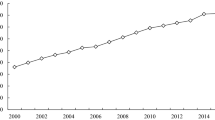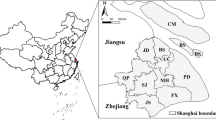Abstract
The future development of new-type urbanization has drawn great attention from both the government and public alike. In this context, the present study had three related research aims. Firstly, it sought to predict the urbanization and population dynamics in China at both national and provincial levels for the period of 2015 to 2030. Secondly, on this basis, it sought to examine the spatial variation of urbanization given the predicted national urbanization rate of 70.12%. Thirdly, it sought to estimate and evaluate the national and provincial demands of investment in the development of new-type urbanization. The main conclusions from this study were as follows: (1) The population size and urbanization rate will reach 1.445 billion and 70.12%, respectively, from 2015 to 2030. (2) The demographic dividend will vanish when the population pressure reaches its maximum. During this period, there will be 70.16 million urban population born. The suburban population that becomes urbanized will be 316.7 million, and thus the net increase in urban population will reach 386 million. (3) Although the urbanization rate of every Chinese province will increase during 2015–2030, it will do so unequally, while differences in urbanization quality among provinces will also be substantial. In some provinces, moreover, the urbanization quality is not compatible with their eco-social development. (4) A total of 4,105,380 billion yuan is required to fund new-type urbanization and the investment demand for each province varies greatly; for example, Guangdong province requires the most funding, amounting to approximately 148 times that required by Tibet, the province in least need of funding. In the final part of this study, policy suggestions concerning the investment of the new-type urbanization are put forward and discussed.
Similar content being viewed by others
References
An J S, 2004. Study on some laws of migration in ancient China. Geographical Research, 23(5): 667–676. (in Chinese)
Bao C, 2014. Spatiotemporal coupling relationships among urbanization, economic growth and water use change in China. Acta Geographica Sinica, 69(12): 1799–1809. (in Chinese)
British Media Forecast (BMF), 2014. China beyond American economy in 2021. Reference News, 08-25(3).
Cai F, 2007. China Population and Sustainable Development. Beijing: Science Press. (in Chinese)
Cao G Z, Liu T, 2011. Rising role of inland regions in China’s urbanization in the 21st century: The new trend and its explanation. Acta Geographica Sinica, 66(12): 1631–1643. (in Chinese)
Chen J Y, Cai F, 2004. The reformation of household register system and population mobility between urban and suburban in China. China Labor Economics, 117–118. (in Chinese)
Chen M, Wang K, 2013. Speed and tendency of China’s urbanization: Comparative study based on cross-country panel data model. China City Planning Review, 37(5): 16–21. (in Chinese)
Chen M X, 2015. Research progress and scientific issues in the field of urbanization. Geographical Research, 34(4): 614–630. (in Chinese)
Chen M X, Lu D D, Zhang H, 2009. Comprehensive evaluation and the driving factors of China’s urbanization. Acta Geographica Sinica, 64(4): 387–398. (in Chinese)
Chen M X, Tang Z P, Bai Y P, 2013. Relational pattern of urbanization and economic development: The parameter revaluation of Chenery’s Model. Acta Geographica Sinica, 68(6): 739–749. (in Chinese)
Chen M X, Ye C, Zhou Y, 2011. Urbanization rate and its policy implications: Discussion and development of Northam’s curve. Geographical Research, 30(8): 1499–1507. (in Chinese)
Chen M X, Zhang H, Liu W D et al., 2014. The global pattern of urbanization and economic growth: Evidence from the last three decades. PloS One, 9(8): e103799.
Chen Q S, 2014. Macro thinking on financial of the new urbanization: At least 50 trillion of funds. China Enterprise News, 04–08. (in Chinese)
Chen R, 2012. The Urbanisation Roads of the World and China. Beijing: Social Sciences Academic Press. (in Chinese)
Diener E, Suh E, 1997. Measuring quality of life: Economic, social, and subjective indicators. Social Indicators Research, 40(2): 189–216.
Fang C L, Liu X L, 2009. Temporal and spatial differences and imbalance of China’s urbanization development during 1950–2006. Journal of Geographical Sciences, 19(6): 719–732.
Gao G L, Ji R J, 1995. Research on population migration in the process of regional economic development: A case study of Pearl River Delta in Guangdong Province. Economic Geography, 15(2): 76–82. (in Chinese)
Gu C L, Yu T F, Li W M et al., 2008. The Pattern, Process and Mechanism of Urbanization in China. Beijing: Science Press. (in Chinese)
Gu S Z, Zheng C, Cao Y B, 2014. Strategic thinking on developing small and medium-sized cities to balance urbanization. Population Research, 38(4): 19–26. (in Chinese)
Guan W H, Lin Z S, Lu Y Q et al., 2008. Study on the regional difference of urbanization level since 1978 in China. China Soft Science, 16(9): 74–89. (in Chinese)
Guo Z Y, Ding G, 2006. The study on the forecasting methods of urbanization level. Population and Economy, 36(6): 3–8.
Hu A G, Yan Y L, Wei X, 2011. China Towards Common Prosperity for 2030. Beijing: China Renmin University Press. (in Chinese)
Jian X H, Huang K, 2010. Empirical analysis and forecast of the level and speed of urbanization in China. Economic Research Journal, (3): 28–39. (in Chinese)
Jiang H Q, Liu N L, Lu Y L et al., 2013. Research Report on China’s Four Regional Environmental Economic Situation Analysis and Forecast (2012–2030). Beijing: China Environmental Science Press. (in Chinese)
Jiao X Y, 2015.An analysis on the peri-urbanization problem in the process of China’s urbanization and the countermeasures. Contemporary Economic Management, 37(3): 64–67. (in Chinese)
Li A M, 2013. Peri-urbanization in China. Population Research, 37(4): 80–91. (in Chinese)
Li K Q, 2016. China economy will develop better and better. Reference News, 02–17. (in Chinese)
Li Q, Chen Y L, Liu J M, 2012. On the “Development Mode” of Chinese urbanization. Social Sciences in China, (7): 82–100. (in Chinese)
Lin T J, Xuan C, 2015. The State of China’s New Urbanization Development 2015. Beijing: Peking University Press. (in Chinese)
Liu C L, Liu W D, Lu D D, 2014. A study of the geographical features and implications of eco-compensation. Geographical Research, 33(5): 803–816. (in Chinese)
Liu J X, Li N, 2013. Dynamic’s analysis and prediction of urban and rural population. Mathematics in Practice and Theory, 43(18): 68–77.
Liu M G, 2015. Road choice for China in the 21st century. Reformation & Strategy, 31(2): 26–33. (in Chinese)
Lu D D, Yao S M, Liu H et al., 2007. 2006 China Regional Development Report: Urbanization Process and Spatial Expansion. Beijing: The Commercial Press. (in Chinese)
Ma W H, 2013. China development bank expects urban construction funds in China to 25 trillion in the next 3 years. China Times, 12–20. (in Chinese)
Ma Y W, 2014. Reflections on urbanization construction funds problems in China. Financial and Economic Review, 5(1): 23–32. (in Chinese)
Mao Z D, 1999. Speech at the symposium on the issue of socialist transformation of capitalist industry and commerce in 1955. In: Mao Zedong’s Collected Works. Beijing: People’s Publishing House. (in Chinese)
Ministry of Housing and Urban-Rural Construction of the People’s Republic of China (MHURC, PRC), 2014. Chinese City Construction Statistical Yearbook (2013). Beijing: China Statistics Press. (in Chinese)
National Development and Reform Commission, P. R. China (NDRC, PRC), 2015. The Population and Social Development Report 2014. Beijing: National Development and Reform Commission, P. R. China. (in Chinese)
Niu W Y, 2010. China’s New Urbanization Report (2010). Beijing: Science Press. (in Chinese)
Pan J H, Wei H K, 2013. Chinese City Development Report (2013). Beijing: Social Sciences Academic Press. (in Chinese)
Rob U, Talukder M N, 2012. Urbanization prospects in Asia: A six-country comparison. International Quarterly of Community Health Education, 33(1): 23–37.
Robin L C, 2004. Global shift: Reshaping the global economic map in the 21st century by Peter Dicken. Economic Geography, 80(4): 411–412.
Seto K C, Sánchez-Rodríguez R, Fragkias M, 2010. The new geography of contemporary urbanization and the environment. Annual Review of Environment and Resources, 35(1): 167–194.
Seto K C, Satterthwaite D, 2010. Interactions between urbanization and global environmental change. Current Opinion in Environmental Sustainability, 2(3): 127–128.
Shafer C S, Lee B K, Turner S, 2000. A tale of three greenway trails: User perceptions related to quality of life. Landscape and Urban Planning, 49: 163–178.
Shang J, 2013. The Road of Urbanization with Chinese Characteristics. Beijing: Science Press. (in Chinese)
Shen Y, Chai Y W, 2013. Daily activity space of suburban mega-community residents in Beijing based on GPS data. Acta Geographica Sinica, 68(4): 506–516. (in Chinese)
Shi Y S, 2013. Analysis of capital requirement and its sources for development of new-type urbanization in China. China Land Sciences, 27(12): 3–11. (in Chinese)
Sun F H, 1999. Theoretical study and practical exploration on the shift of rural surplus labour. Progress in Geography, 18(2): 111–117. (in Chinese)
The EIU China Research Team, 2014. China urbanization in 2003. China Police Review, 19(7): 93–98. (in Chinese)
The Research Group of the State Council Development Research Center (RGSCDRC), 2011. Citizenizing the Rural Migrants. Beijing: China Development Press. (in Chinese)
The State Council, 2014. National New Urbanization Planning (2014–2020). Beijing: People’s Publishing House. (in Chinese)
The United Nations Development Programme (UNDP), 2013. China National Human Development Report 2013. Beijing: China Translation & Publishing Corporation.
Tian X Y, 2006. Alert Latin American Trap of population urbanization. Macroeconomics, 27(2): 12–17. (in Chinese)
Wang H, Chen L, 2006. Review on the development theories of rural and urban areas in West. Economic Geography, 26(3): 463–468. (in Chinese)
World Bank, State Council Development Research Center (SB and SCDRC), 2013. 2030 China: Construction Modern Harmonious and Creative Society. Beijing: China Financial & Economic Publishing House.
Xu X Q, Yeh G, 1986. Provincial variation of urbanization in China. Acta Geographica Sinica, 41(1): 8–22. (in Chinese)
Yan X P, Wei L H, Zhou R B, 2004. Research on the coordination between urban and rural area in the rapid urbanization with the redevelopment of Guangzhou village-amid-the-city as a case. China City Planning Review, 28(3): 30–38. (in Chinese)
Yang Q W, 2014. Annual Report on the Development of China’s Investment (2013). Beijing: Social Sciences Academic Press. (in Chinese)
Yang Z H, Shi L, 2014. The strategy prepare of Chinese new urbanization. Journal of Management, 27(2): 28–34. (in Chinese)
Yao H S, Xu X Q, 2008. Progress of research on migration in western countries. World Regional Studies, 17(1): 154–166. (in Chinese)
Yao S M, Lu D D, Chen Z G et al., 2012. Serious problems of urbanization: Under the national conditions of China. Economic Geography, 32(5): 1–6. (in Chinese)
Yu X J, 2009. Change of population, expanding domestic demand and economic growth. Population Research, 33(5): 36–41. (in Chinese)
Zhang J X, Fan C L, 2002. On administrative division adjustment and urbanization promotion. Urban Planning Forum, (5): 25–28. (in Chinese)
Zhang J Y, Wang G X, Li J, 2004. Population changes in urbanization progress and the influence on land use in Suizhou City. Progress in Geography, 23(4): 87–96. (in Chinese)
Zhang S Y, 2002. Deference analysis on regional urbanization development level in China. Population Journal, (5): 37–42. (in Chinese)
Zheng B W, 2011. The lessons of Latin American and China urbanization problems. Foreign Theoretical Trends, 20(7): 46–51. (in Chinese)
Zheng B W, 2011. Urbanization in Latin America & Caribbean: Experiences and Lessons. Beijing: The Contemporary World Press. (in Chinese)
Author information
Authors and Affiliations
Corresponding author
Additional information
National Natural Science Foundation of China, No.41501137, No.41530634, No.41271186
Sun Dongqi (1985–), PhD, specialized in economic geography and regional development.
Li Yu (1973–), Associate Professor, specialized in urbanization and its eco-environment effects.
Rights and permissions
About this article
Cite this article
Sun, D., Zhou, L., Li, Y. et al. New-type urbanization in China: Predicted trends and investment demand for 2015–2030. J. Geogr. Sci. 27, 943–966 (2017). https://doi.org/10.1007/s11442-017-1414-4
Received:
Accepted:
Published:
Issue Date:
DOI: https://doi.org/10.1007/s11442-017-1414-4




